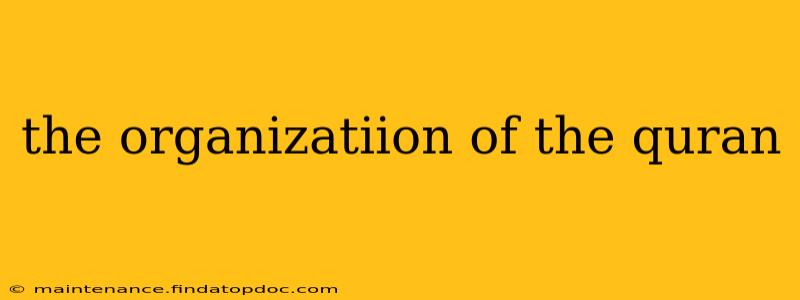The Quran, the central religious text of Islam, is not simply a collection of verses; it's a meticulously organized work with a complex internal structure that reflects its theological and historical context. Understanding this organization is crucial to grasping its multifaceted message and appreciating its enduring impact. This exploration delves into the organizational principles of the Quran, examining its structure from various perspectives.
What is the chronological order of the Quran?
Determining the exact chronological order (or tarikh al-nuzul) of the Quranic revelations is a complex task that has occupied Islamic scholars for centuries. The Quran itself doesn't present its verses in chronological order. Instead, it's arranged thematically and structurally, prioritizing the conveyance of its message over strict chronological sequencing. While there's no universally agreed-upon chronological arrangement, various scholarly attempts exist, based on analyzing linguistic styles, historical context, and references within the verses themselves. These efforts, however, remain a subject of ongoing scholarly debate and refinement. The absence of a definitive chronological arrangement doesn't diminish the Quran's impact; its thematic arrangement powerfully contributes to its message's overall impact.
How is the Quran organized?
The Quran is primarily organized into 114 chapters, known as suras. These suras vary significantly in length, ranging from just a few verses to over 200. The suras are further divided into verses, or ayahs. The arrangement of the suras isn't purely random. While chronological order isn't followed, there's a discernible pattern reflecting thematic progression and structural coherence. Longer suras, often dealing with foundational doctrines and legal matters, tend to be placed earlier in the text, while shorter suras, sometimes focusing on specific events or moral teachings, are positioned later.
Why isn't the Quran organized chronologically?
The non-chronological arrangement of the Quran is deliberate. Its structure prioritizes thematic unity and the gradual unveiling of its message. Presenting the revelations chronologically might have fragmented the overall narrative and obscured the interconnectedness of its various themes. The current organization allows readers to encounter a cohesive and progressively revealing message, enhancing understanding and promoting reflection. The thematic organization emphasizes the interconnectedness of divine commandments, stories, and moral teachings, contributing to a more impactful and spiritually enriching reading experience.
What are the main themes in the Quran's organization?
The Quran's thematic organization revolves around several central themes, including:
- Tawhid (Oneness of God): This foundational concept pervades the entire Quran, emphasizing the absolute sovereignty and unique nature of God.
- Prophethood: The Quran narrates the stories of numerous prophets, highlighting the consistent message of God's guidance across different eras.
- Accountability and Judgement: The Quran emphasizes the importance of moral responsibility and the eventual reckoning before God.
- Moral and Ethical Guidance: The Quran provides detailed guidance on various aspects of life, emphasizing justice, compassion, and piety.
- Legal and Social Prescriptions: The Quran establishes guidelines for social interactions, economic transactions, and legal matters.
Does the order of the suras in the Quran have any significance?
Yes, the order of the suras contributes significantly to the Quran's overall meaning and impact. The arrangement allows for a gradual unfolding of themes, a building of concepts, and a powerful rhetorical effect. While scholars debate the precise rationale behind the arrangement, the current structure is not arbitrary. It facilitates a structured journey through the Quran’s teachings, leading the reader from foundational concepts to more nuanced interpretations and practical applications. The organization enhances the narrative flow, fostering a deeper understanding of the Quran’s message.
Conclusion:
The organization of the Quran is a complex and multifaceted subject. While not chronologically sequenced, its thematic and structural organization is deliberate and meaningful, contributing significantly to its profound impact. Understanding this organization is key to appreciating the Quran's message and its enduring relevance in shaping Islamic thought and practice. Further research into the various scholarly approaches to understanding the Quran's structure can offer a deeper insight into this fascinating aspect of Islamic scripture.
